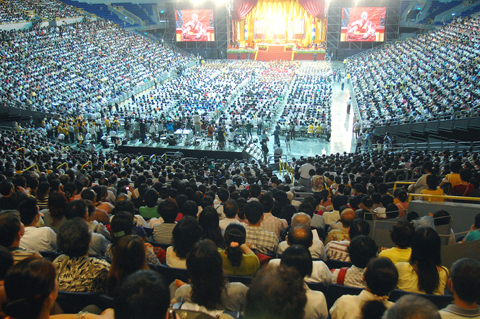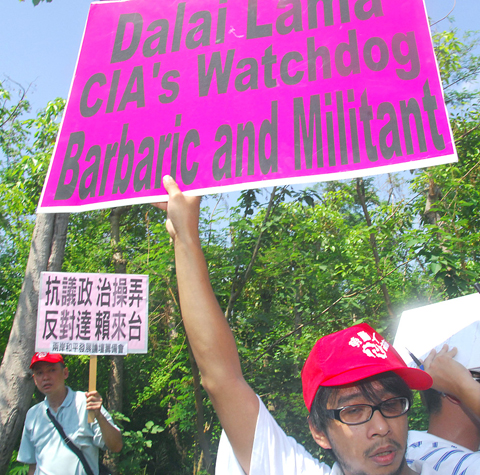More than 17,000 people from across the country packed the Kaohsiung Arena yesterday morning as the Dalai Lama held a two-hour prayer ceremony for the victims of Typhoon Morakot.
Although the ceremony officially started at 9:30am, many people began lining up on Monday night and by 9am the stadium was packed.
Admission to the event was on first-come-first-serve basis beginning at 7:30am.

PHOTO: PATRICK LIN, AFP
Aside from locals, hundreds of people arrived from Taipei via charter bus at about 6am.
Awaiting the spiritual leader’s arrival, members of the audience chanted om mani padme hum — the most commonly recited Buddhist mantra — in unison.
“I came here not to take pictures but to do something meaningful,” the Dalai Lama told the audience.

PHOTO: PATRICK LIN, AFP
“All Buddhists today — monks, men and women — must bear compassion at heart, pray and dedicate all the merits to the deceased and their families,” he said.
“Many people asked if we want to do good things and pray, why don’t we just do it in our own rooms? Well, when so many people are gathered here at the same time to pray, we could create a very powerful force that would generate special fruits,” he said.
The leader led the audience in reciting Buddhist chants and commented on the teachings of the Buddha.
He also urged the public to think positively and live their lives without losing confidence, even in difficult times.
“More than 500 people lost their lives in the disaster and the survivors are very worried,” he said.
“But in Linbian Township [林邊, Pingtung County], a lot of fish were able to escape [from fishponds] because of the flooding,” he said, followed by laughter from the audience.
Many people in attendance said they were impressed by the Dalai Lama’s wittiness in his teachings on a subject that can sometimes be dry, as well as his quick reaction to unexpected events.
“It was spectacular and the Dalai Lama was so witty, I loved how he reacted to the collapse of the table, which could have been an embarrassing moment,” a member of the audience surnamed Chao (趙) said after the ceremony was over.
At the beginning of the ceremony, the Dalai Lama asked that a small table in front of his seat be removed. However, as officials were in the process of removing it, it collapsed, to a complete silence in the audience.
The Dalai Lama broke the silence with loud laughter, which triggered more laughter and applauses from the crowd.
Chen Yu-ching (陳毓青), a follower of Tibetan Buddhism, said she was excited to see the Dalai Lama in person for the first time.
“I’m so happy, because I don’t know if I’ll have another chance to see the Dalai Lama again,” she said, adding that she took the day off from work and got up at 5am to drive down from Taichung for the event.
The 1989 Nobel Peace Prize-winner gave another lecture at an auditorium at his hotel in the afternoon.
Most of the problems that trouble our world are manmade, he said, and they can only be resolved when people consider all 6 billion human beings as brothers as sisters.
Many are “too much concerned about the ‘we’ and ‘they’ and are willing to sacrifice one’s life to destroy ‘the other,’” he said.
“That’s foolish, unwise,” he said.
“Think of humanity as part of ‘we,’” he said, adding that thought alone would not resolve all problems, but that problems can be resolved through compromise and dialogue.
Admission tickets for the afternoon lecture were distributed at the hotel starting at noon, with all 500 tickets gone in half an hour.
Unable to secure tickets for the lecture, more than 1,000 people stayed in the hotel lobby and courtyard, hoping to greet the Dalai Lama after the lecture. However, the Dalai Lama returned to his room directly after the lecture.
Not everyone welcomed the Dalai Lama.
Dozens of people from the China Unification Promotion Party (CUPP) and the True Awakening Joint Cultivation Buddhist Association (正覺佛教同修會) staged protests outside the Kaohsiung Arena in the morning and the hotel in the afternoon.
CUPP members shouted slogans accusing the Dalai Lama of engaging in “separatist” activities and claiming that Tibet and Taiwan are part of China.
Members from the True Awakening Buddhist Joint Cultivation Association, meanwhile, held up banners saying that the Dalai Lama refuses to accept the true teachings of the Buddha.
The group, established in 1997, represents a newly evolved Buddhist faction and is strongly critical of Tibetan Buddhism.
At a separate setting yesterday, Premier Liu Chao-shiuan (劉兆玄) said the visit by the Dalai Lama would influence cross-strait relations, but that the government hoped the impact would be minimal and of short duration.
“If the visit remains confined to humanitarian and religious subjects and is purely for the purpose of consoling the souls of the victims, it won’t be a big problem,” Liu told a press conference at the 8th Field Army in Kaohsiung Country’s Cishan Township (旗山), where Cabinet officials set up a makeshift office to oversee resettlement of victims and reconstruction in the wake of Morakot.
Liu said it was impossible to measure the extent of the influence the visit by the Dalai Lama would have on cross-strait relations because “it’s sort of abstract” and the visit is “just beginning.”
Asked whether the visit would hinder the government’s agenda for signing an economic cooperation framework agreement with China, Liu said the matter was “not a unilateral decision” but depended on “how the two sides interact with each other.”
Liu would not comment on the nature of the communication that had occurred between Taiwan and China on the visit by the Dalai Lama, saying that he “was not involved” but was “aware of the process.”
“We had some information and made some impact assessments … But to say more about this would do no good,” Liu said.
Meanwhile in Taipei, Chinese Nationalist Party (KMT) Legislator Lee Hung-chun (李鴻鈞) said the government should take this opportunity to review whether Taiwan is overly dependent on China.
KMT Legislator Lo Shu-lei (羅淑蕾) said the government needed to patch up the nation’s relations with Beijing as soon as possible because between 60 percent and 70 percent of Taiwan’s exports go to China.
ADDITIONAL REPORTING BY FLORA WANG

TRAGEDY STRIKES TAIPEI: The suspect died after falling off a building after he threw smoke grenades into Taipei Main Station and went on a killing spree in Zhongshan A 27-year-old suspect allegedly threw smoke grenades in Taipei Main Station and then proceeded to Zhongshan MRT Station in a random killing spree that resulted in the death of the suspect and two other civilians, and seven injured, including one in critical condition, as of press time last night. The suspect, identified as a man surnamed Chang Wen (張文), allegedly began the attack at Taipei Main Station, the Taipei Fire Department said, adding that it received a report at 5:24pm that smoke grenades had been thrown in the station. One man in his 50s was rushed to hospital after a cardiac arrest

A car bomb killed a senior Russian general in southern Moscow yesterday morning, the latest high-profile army figure to be blown up in a blast that came just hours after Russian and Ukrainian delegates held separate talks in Miami on a plan to end the war. Kyiv has not commented on the incident, but Russian investigators said they were probing whether the blast was “linked” to “Ukrainian special forces.” The attack was similar to other assassinations of generals and pro-war figures that have either been claimed, or are widely believed to have been orchestrated, by Ukraine. Russian Lieutenant General Fanil Sarvarov, 56, head

SAFETY FIRST: Double the number of police were deployed at the Taipei Marathon, while other cities released plans to bolster public event safety Authorities across Taiwan have stepped up security measures ahead of Christmas and New Year events, following a knife and smoke bomb attack in Taipei on Friday that left four people dead and 11 injured. In a bid to prevent potential copycat incidents, police deployments have been expanded for large gatherings, transport hubs, and other crowded public spaces, according to official statements from police and city authorities. Taipei Mayor Chiang Wan-an (蔣萬安) said the city has “comprehensively raised security readiness” in crowded areas, increased police deployments with armed officers, and intensified patrols during weekends and nighttime hours. For large-scale events, security checkpoints and explosives

PUBLIC SAFETY: The premier said that security would be tightened in transport hubs, while President Lai commended the public for their bravery The government is to deploy more police, including rapid response units, in crowded public areas to ensure a swift response to any threats, President William Lai (賴清德) said yesterday after a knife attack killed three people and injured 11 in Taipei the previous day. Lai made the remarks following a briefing by the National Police Agency on the progress of the investigation, saying that the attack underscored the importance of cooperation in public security between the central and local governments. The attack unfolded in the early evening on Friday around Taipei Main Station’s M7 exit and later near the Taipei MRT’s Zhongshan